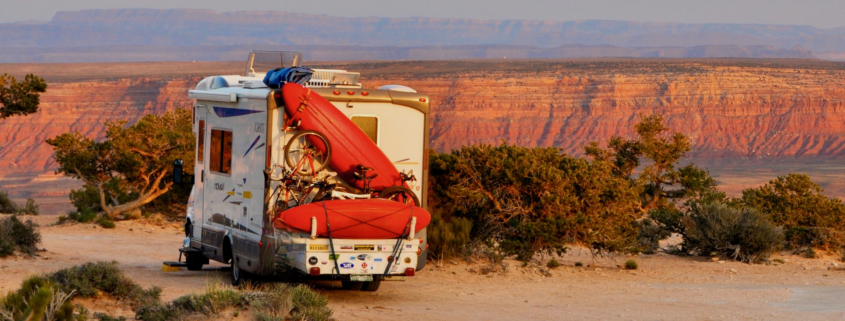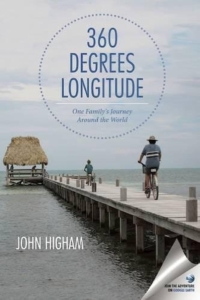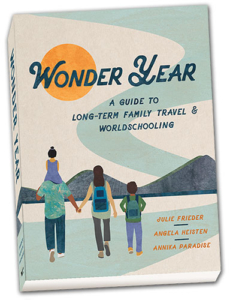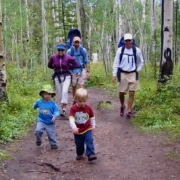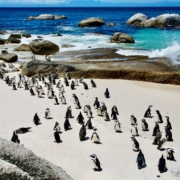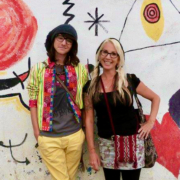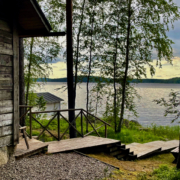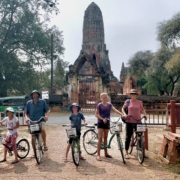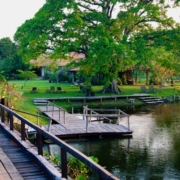Four Worldschooling Memoirs to Get Your Wheels Turning
Whether you are new to the idea, actively planning your journey, or have been on the road for years, books can remind you why you’re choosing the road less taken. These four memoirs, each written by a worldschooling parent about their family’s journey, paint the picture of just how remarkable long-term family travel can be.
Using the world as a classroom is a fantastic way to teach your kids. But leaping into long-term family travel and worldschooling requires courage and conviction. Sometimes you need inspiration to help you believe that leaving (almost) everything behind could be totally worth it. Or, you might be in the dreaming stage, not yet ready or able to launch but longing to explore from home and immerse yourself in stories of what is possible.
360 Degrees Longitude: One Family’s Journey Around the World by John Higham
The OG of worldschooling memoirs, 360 Degrees Longitude: One Family’s Journey Around the World was released in 2009, years before e-readers caught on and trip planning was done via apps. Author John Higham and his wife September began planning their trip ten years before leaving their comfortable Bay Area life for an around-the-world adventure. This memoir is the story of their journey and an inspiring must-read for others hoping to travel long term with their family, too.
Higham brings the reader along chronologically on a trip spanning 12 months, 24 time zones, and 28 countries. Engaging and funny, he couples anecdotes with thoughtful descriptions of destinations and the people his family meets along the way. His two children, Katrina, 11, and Jordan, 8, when their trip begins, are always in the loop–helping choose destinations and plan adventures. Designed partially as a biking trip across Europe, a playground accident in Switzerland leaves Katrina with a broken leg. The family nimbly adjusts to this and a series of other misadventures that Higham never shies away from sharing with would-be travelers. Entries from the kids’ journals round out his story, as does John’s innovative use of Google Earth, which allows readers to access photos and videos of destinations the Highams visited across the globe. Clever (or, using John’s term, “stupid”) facts at the end of the book punctuate the experience.
360 Degrees Longitude helped lay the groundwork for what it means to be a citizen of the world. Highlighting what their family learned along the way, the author shows it’s possible to navigate almost anything when they’re doing it together. As Higham shares in his introductory message, he wrote the book to “take you to distant lands and meet the people who live over there to show that, at the end of the day, humankind in all its wonderful weirdness is the same all over the planet.”
The World is Our Classroom: How One Family Used Nature and Travel to Shape and Extraordinary Education by Cindy Ross
Ross, a lifelong writer, began worldschooling her kids in the ’90s. The term worldschooling was either extremely niche or nonexistent,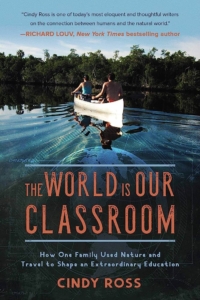 but her interactions with her children and the world define the term organically. She began by spending time in nature and in the garden with her very young kids, wondering together before Google could explain. They spent summers hiking the Continental Divide with toddlers and llama support, learned American history by riding a Conestoga wagon along the Oregon Trail, and even partnered with local naturalists for their science lessons. The notion of learning from participation with the world grew naturally from these experiences. Her chapters have titles like “Learning from Play,” “Learning from International Travel” and “Learning about Values and Priorities.” Each chapter is full of anecdotes and ends with a section called “Nuts and Bolts” to outline how to get it done.
but her interactions with her children and the world define the term organically. She began by spending time in nature and in the garden with her very young kids, wondering together before Google could explain. They spent summers hiking the Continental Divide with toddlers and llama support, learned American history by riding a Conestoga wagon along the Oregon Trail, and even partnered with local naturalists for their science lessons. The notion of learning from participation with the world grew naturally from these experiences. Her chapters have titles like “Learning from Play,” “Learning from International Travel” and “Learning about Values and Priorities.” Each chapter is full of anecdotes and ends with a section called “Nuts and Bolts” to outline how to get it done.
This book outlines how worldschooling looked before online education and screens were a thing. There are thousands of ideas to inspire you if you want less time on tech. Ross and her husband also kept their kids in public schools and supplemented their education incrementally with long stretches in the American wilderness and in more than 12 countries.
The memoir has the strength of perspective. Ross’ children are now in their late 20s, and the book weaves the roots of their current passions into the narrative. Sierra and Bryce (also the illustrator) each have several pages at the end where they sum up their childhood in their own words. These words by Sierra, as she describes her current work in environmental stewardship, particularly struck me. She says, ” [Experiential education] is a cycle whereby we become informed about the world by participating in it, and with this knowledge are both empowered and gain the tools to change it.”
How to Be a Family: The Year I Dragged My Kids Around the World to Find A New Way To Be Together by Dan Kois
So many parents are pressured by and face tough questions about modern-day work, “screen age” parenting, and the realization that life is short. But it takes a moment of awakening or some sort of existential shake-up to pull up stakes and get out of one’s bubble. Dan Kois,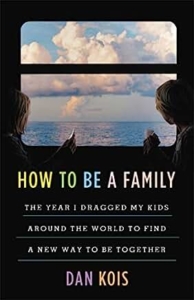 his wife Alia, and daughters Harper and Lyra did just that. In search of greater connection and meaning, they set out on a global family adventure that took them to New Zealand, the Netherlands, Costa Rica, and rural small-town America in Hayes, Kansas. How to Be a Family is an honest, hilarious, and heartfelt account of the experience of togetherness through the fantastic and the mundane, the gorgeous and the gross.
his wife Alia, and daughters Harper and Lyra did just that. In search of greater connection and meaning, they set out on a global family adventure that took them to New Zealand, the Netherlands, Costa Rica, and rural small-town America in Hayes, Kansas. How to Be a Family is an honest, hilarious, and heartfelt account of the experience of togetherness through the fantastic and the mundane, the gorgeous and the gross.
The raw and accessible quality of this book invites readers into the metaphor of life as a journey. We feel the Kois family dynamics, their vulnerabilities and victories. Anyone who has experienced long-term family travel might chuckle throughout, knowing exactly how it feels to be tumbled into a family unit while living outside of your comfort zone. But whether or not you have taken a trip around the world, How to Be a Family is a good read, a parenting odyssey that will entertain, inspire, and challenge you to think about your parenting style and family culture. Many parents want their kids to feel engaged and connected and have agency in their own lives. Travel is empowering that way. Kois captures it beautifully when he writes, “…and the thing I love most about this trip is the way that moments from this year are already becoming family lore, retold by children who are finally old enough to contribute to their own tales.”
How to Become a Family reminds us that sometimes the best adventure is the one where we’re simply together with family and friends.
We Came, We Saw, We Left by Charles Wheelan
We Came, We Saw, We Left is a fascinating story about one family’s experiment in taking a gap year. Intelligent and full of charm, the Wheelan family solves one problem after another and strings together nine months of adventure, mishaps, deep learning, and 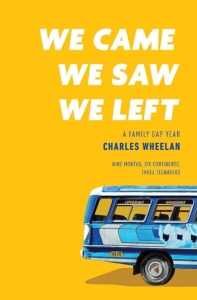 togetherness. An economist, professor, and author, Charles Wheelan also has a way with storytelling, especially when it comes to acquainting you with the idiosyncrasies and proclivities of his three kids. Many readers will feel inspired to start planning their own family gap year after reading We Came, We Saw, We Left. Others may be spooked and instead plant a garden.
togetherness. An economist, professor, and author, Charles Wheelan also has a way with storytelling, especially when it comes to acquainting you with the idiosyncrasies and proclivities of his three kids. Many readers will feel inspired to start planning their own family gap year after reading We Came, We Saw, We Left. Others may be spooked and instead plant a garden.
This travel memoir offers a great job of portraying the imperfections and improvisations that go along with long-term family travel. For example, day 10 for Team Wheelan was marked by a lost pair of kiddos in Medellin, Colombia. On the verge of panic, Charles and his partner, Leah, held their breath and resisted accusation while they waited on the metro platform for that text to come, which it eventually did. Buoyed by reunion and a round of beverages, the family recounted their errors: “Over dinner, we reviewed our ‘rookie mistakes’: taking the metro at rush hour; not making sure we all knew the stop; not having a plan if we were separated; not giving enough money to Katrina for a taxi; and so on.” Overcoming a mega-obstacle early on, talking about it, and learning from it together, gave the family confidence. They recounted, “Maybe we would be able to pull off this crazy adventure travel thing after all.”
We Came, We Saw, We Left draws you into the rhythm of the road–into spaces where kids don’t go off to school and parents don’t go off to work. It shows that on a family gap year, things get mixed up at the edges while bonds of togetherness grow stronger around every unexpected turn.
While there are many other worldschooling memoirs out there, these first four will get you started. Full of inspiration, perspective, poignancy, and humor, they might just be a litmus test for you: Could this lifestyle be for me? Is it something I want to do for a summer? A year? Or, perhaps I’m selling everything to buy a one-way ticket?
All of these books are available as e-books at Bookshop.org, Barnes & Noble, or Amazon. There’s still time for a great summer read! And if these whet your worldschooling appetite and you need help figuring out what to do next, you can check out our book, too.
